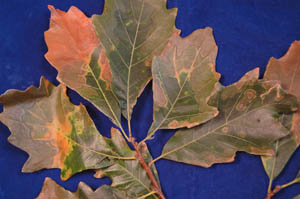2007 Bacterial Leaf Scorch Finds | |
|---|---|
| October 16, 2007 | |
|
Bacterial leaf scorch (BLS) is a disease associated with decline and death of large trees. It is caused by a bacterium, Xylella fastidiosa, which resides in the xylem. Unlike most other bacterial plant pathogens, this one cannot be detected in an ooze test with a microscope or cultured on lab media. Positive finds are confirmed by ELISA (enzyme-linked immunosorbant assay). We have discussed this disease in the Home, Yard, and Garden Pest Newsletter, issue no. 15, 2007, or issues no. 14 and 16, 2006. The most frequent hosts of this disease in the United States include elm, oak, sycamore, mulberry, sweetgum, sugar maple, and red maple. In Illinois, we have identified the problem on oak, specifically pin, red, shingle, bur, and white oaks. The image shows an oak that tested positive for BLS in 2007.  In 2007, to date, the Plant Clinic assayed 22 Illinois samples for Xylella fastidiosa (Xf). Of these, 11 tested positive: 4 pin oaks, 3 red oaks, 1 shingle oak, and 3 oaks of unknown species determination. Interestingly, all were from Champaign County. We tested samples from Douglas, DuPage, Jefferson, Kankakee, McHenry, and Sangamon counties; all were negative. Keep in mind that we test only what is sent to us, so this information is not a survey of the disease in Illinois.�� | |
| Author: | Nancy Pataky |
